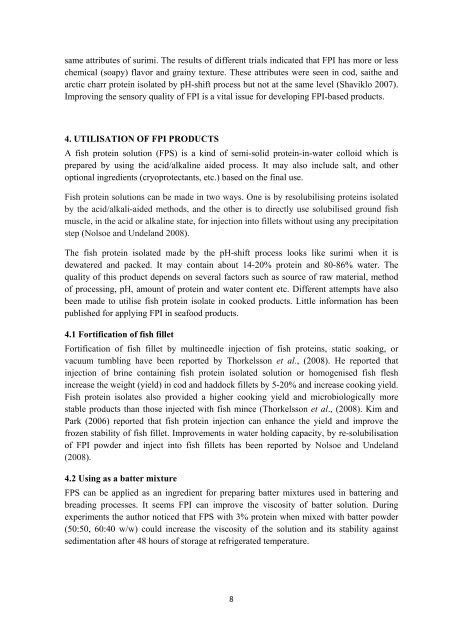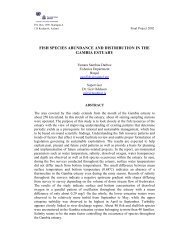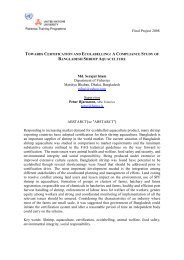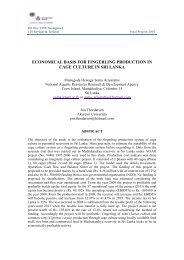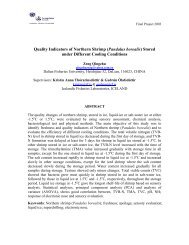Evaluation and Utilisation of Fish Protein Isolate Products
Evaluation and Utilisation of Fish Protein Isolate Products
Evaluation and Utilisation of Fish Protein Isolate Products
- No tags were found...
You also want an ePaper? Increase the reach of your titles
YUMPU automatically turns print PDFs into web optimized ePapers that Google loves.
same attributes <strong>of</strong> surimi. The results <strong>of</strong> different trials indicated that FPI has more or lesschemical (soapy) flavor <strong>and</strong> grainy texture. These attributes were seen in cod, saithe <strong>and</strong>arctic charr protein isolated by pH-shift process but not at the same level (Shaviklo 2007).Improving the sensory quality <strong>of</strong> FPI is a vital issue for developing FPI-based products.4. UTILISATION OF FPI PRODUCTSA fish protein solution (FPS) is a kind <strong>of</strong> semi-solid protein-in-water colloid which isprepared by using the acid/alkaline aided process. It may also include salt, <strong>and</strong> otheroptional ingredients (cryoprotectants, etc.) based on the final use.<strong>Fish</strong> protein solutions can be made in two ways. One is by resolubilising proteins isolatedby the acid/alkali-aided methods, <strong>and</strong> the other is to directly use solubilised ground fishmuscle, in the acid or alkaline state, for injection into fillets without using any precipitationstep (Nolsoe <strong>and</strong> Undel<strong>and</strong> 2008).The fish protein isolated made by the pH-shift process looks like surimi when it isdewatered <strong>and</strong> packed. It may contain about 14-20% protein <strong>and</strong> 80-86% water. Thequality <strong>of</strong> this product depends on several factors such as source <strong>of</strong> raw material, method<strong>of</strong> processing, pH, amount <strong>of</strong> protein <strong>and</strong> water content etc. Different attempts have alsobeen made to utilise fish protein isolate in cooked products. Little information has beenpublished for applying FPI in seafood products.4.1 Fortification <strong>of</strong> fish filletFortification <strong>of</strong> fish fillet by multineedle injection <strong>of</strong> fish proteins, static soaking, orvacuum tumbling have been reported by Thorkelsson et al., (2008). He reported thatinjection <strong>of</strong> brine containing fish protein isolated solution or homogenised fish fleshincrease the weight (yield) in cod <strong>and</strong> haddock fillets by 5-20% <strong>and</strong> increase cooking yield.<strong>Fish</strong> protein isolates also provided a higher cooking yield <strong>and</strong> microbiologically morestable products than those injected with fish mince (Thorkelsson et al., (2008). Kim <strong>and</strong>Park (2006) reported that fish protein injection can enhance the yield <strong>and</strong> improve thefrozen stability <strong>of</strong> fish fillet. Improvements in water holding capacity, by re-solubilisation<strong>of</strong> FPI powder <strong>and</strong> inject into fish fillets has been reported by Nolsoe <strong>and</strong> Undel<strong>and</strong>(2008).4.2 Using as a batter mixtureFPS can be applied as an ingredient for preparing batter mixtures used in battering <strong>and</strong>breading processes. It seems FPI can improve the viscosity <strong>of</strong> batter solution. Duringexperiments the author noticed that FPS with 3% protein when mixed with batter powder(50:50, 60:40 w/w) could increase the viscosity <strong>of</strong> the solution <strong>and</strong> its stability againstsedimentation after 48 hours <strong>of</strong> storage at refrigerated temperature.8


